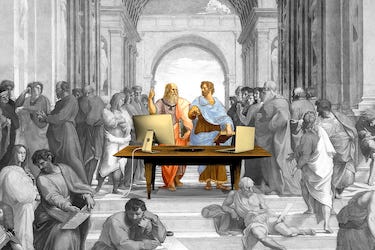
[draft]
Rhetoric. The way in which one communicates in everyday life. These communications can be persuasive in nature and can be made of text, images, video, or any other type of media.
At its core, rhetoric has its roots dating back to ancient Greece. Back then, they focused on persuasion techniques and speech rather than written text. Now, rhetoric encompasses not only speeches and written works, but also visual rhetorics such as images and film.
In today’s media, we often hear terms like “divisive rhetoric” or “bad rhetoric,” which often gives a negative perception of rhetoric even if someone may not understand what it exactly is.
To this day, scholars are still debating the definition of rhetoric and everything it incorporates. Below is a working definition of rhetoric.
What is Rhetoric: A Working Definition
Rhetoric is
Rhetoric requires an understanding and control of language and knowledge of culture; the rhetorical situation which includes the purpose, audience, topic, writer, and context, genre; and other aspects to achieve an intended purpose. In many cases, rhetorical appeals (ethos, pathos, logos) can also contribute to this intended purpose.
The Rhetorical Situation

Purpose
Consider what the purpose of the writing is. Are you writing to inform, evaluate, analyze, or convince?
Audience
When writing anything, consider who is being addressed. Audiences bring in their own perspectives, biases, experiences, and expectations, which can make writing for a particular audience very difficult.
Topic
What are you writing about? The topic may be self-selected or assigned, but writers should try and find an angle that they are motivated to write about. The topic should also be broad enough to fit the assignment’s parameters and specific enough to go into detail.
Writer
Writers, just like their audience, are influenced by a number of things, like their age, location, perspective, bias, culture, experiences, and expectations. Writers may need to consider if the traits they are bringing in may have a positive or negative outcome. For example, even if someone is very passionate about stopping animal testing, to convince others, they may have to show restraint in expressing all of their personal views about people who test products on animals. If these are the people they must convince, no matter what the writer may personally feel, writers should avoid insulting or degrading their audience if they have a chance at motivating change.
Context
The context describes the circumstances surrounding the writing which include the time (when the text is written), location (where is the text placed), events surrounding the writing, and the culture.
Why is Rhetoric Important?
- Since everyone can use rhetoric, an awareness of its prevalence can be empowering and can help you become a more critical consumer and creator.
- It helps you as a writer and reader understand the different and interrelated influences surrounding your writing and how it will be received and interpreted.
- Rhetoric gives you a framework to think critically about your writing and reading choices.
- Knowing how to use the tools of rhetoric can improve your communication and can help more people to agree with your perspective.
- Rhetoric is a careful way of channeling your creative energies and incorporating written/visual/audio compositions to create, affirm, and improve the world around us.
Analyzing a Tweet from Lin-Manuel Miranda’s Twitter Page
Now we will look at a tweet to demonstrate how these features can be rhetorically analyzed. When conducting a rhetorical analysis, generally writers are asked to examine how a particular message is conveyed. This means looking at different aspects or parts of the media to determine the intended effect on the audience.

Tone and Audience
The term “SanFranHam” speaks to the more casual nature of Twitter and is directly addressing an audience familiar with the Hamilton musical’s updates and shows.
Additional Resources
The link to the YouTube video allows viewers to learn more about the contest while still adhering to the then 140 character limit.
Purpose
When Miranda talks about seeing Hamilton with his parents, he is building a more personal relationship with his followers as he invites them to join his family. Literally.
Composition
The center framing and natural lighting puts all focus on him, and his casual, easy half-smile is welcoming and a bit goofy, which appeals to an audience interested in learning more about him.
Wardrobe Choices
Miranda’s Hamilton shirt is a purposeful choice to advertise the show in addition to the contest.
Purpose
“Did you miss me?!” Expresses enthusiasm, but also hints that if Miranda is followed on these platforms, more contest opportunities may become available since this is not the first time a contest has been offered.
Rhetoric is everywhere and is a way to enact change in your world; however, it takes practice to recognize and use rhetoric. Check out our linked resources to learn more about using rhetoric as a tool in your everyday life. Remember—rhetoric can be a catalyst for change in your world and the lives of people in it, but it is up to you whether or not to harness this power.